Grand Tour of the Coronal Loops Model
|
This is a longer coronal loops tour combining components of the two previous versions (Animation IDs 3286 and 3287). The solar model is constructed from magnetogram data collected by SOHO/MDI. Because we do not see the full solar surface at any one time, the magnetograms collected over the course of a solar rotation are processed through a time-evolving solar surface model which provides a snapshot of the surface at a fixed time. The resulting magnetogram is then processed through the Potential Field Source Surface (PFSS) model which constructs the magnetic field above the solar surface. The magnetic field around the Sun is then analyzed for field lines, which creates the loop structures we see in the model. Hot plasma tends to flow along the magnetic field lines, creating the coronal loops. These loops are only visible at the higher temperatures corresponding to ultraviolet light, in this case, 195 Ångstroms, one of the filter wavelengths of SOHO/EIT. For this version, we color the coronal loops green for ready comparison to the EIT 195 Ångstrom imagery using the EIT standard color table.
|
|
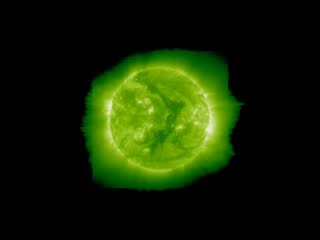
|
|
Starting with an animated view of SOHO/EIT data, we fade to a coronal loops model constructed from SOHO/MDI magnetogram data and the PFSS model. After a spin around the model, we zoom in for a 'through the loops' fly-through.
Duration: 1.2 minutes
Available formats:
320x240 (30 fps)
MPEG-1
12 MB
640x480 (30 fps)
MPEG-1
49 MB
720x480 (30 fps)
MPEG-2
55 MB
720x480 (29.97 fps)
Frames (Main)
320x240
JPEG
11 KB
1280x720 (29.97 fps)
MPEG-2
160 MB
1280x720 (29.97 fps)
MPEG-4
68 MB
1280x720 (29.97 fps)
Frames (Main)
How to play our movies
|
|
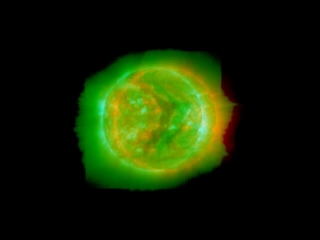
|
|
This is a stereographic version of the movie. Red/Cyan stereo glasses are required to view it properly. 
Duration: 1.2 minutes
Available formats:
720x480 (29.97 fps)
Frames (Left)
720x480 (29.97 fps)
Frames (Right)
320x240 (30 fps)
MPEG-1
4 MB
640x480 (30 fps)
MPEG-1
65 MB
720x480 (30 fps)
MPEG-2
66 MB
320x240
JPEG
16 KB
720x480 (29.97 fps)
Frames (RedCyan)
640x480 (29.97 fps)
MPEG-4
69 MB
1280x720 (29.97 fps)
Frames (Lefteye)
1280x720 (29.97 fps)
Frames (Righteye)
How to play our movies
|
|
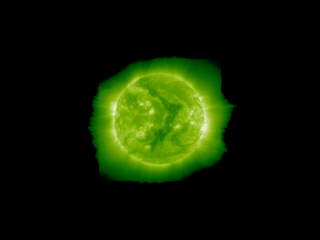
|
|
We open with a time-series of EIT/195 Ångstrom images. The ultraviolet corona has been extended beyond the EIT image using a power-law falloff function fitted to the data.
Available formats:
2560 x 1920
TIFF
1 MB
320 x 240
PNG
26 KB
|
|
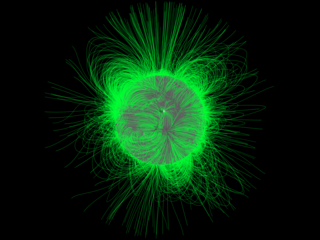
|
|
Next we fade out the EIT data to view the PFSS model and magnetogram.
Available formats:
2560 x 1920
TIFF
2 MB
320 x 240
PNG
59 KB
|
|
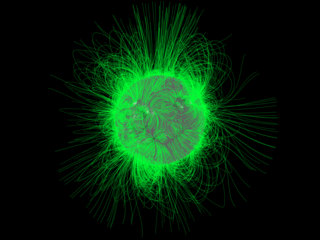
|
|
We spin the solar model to observe the loop structures.
Available formats:
2560 x 1920
TIFF
2 MB
320 x 240
PNG
58 KB
|
|
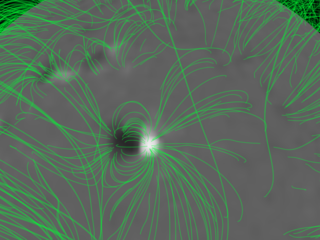
|
|
We move closer to the surface of the model, near a small sunspot where we see the dipole structure of the field lines and spot region.
Available formats:
2560 x 1920
TIFF
3 MB
320 x 240
PNG
106 KB
|
|
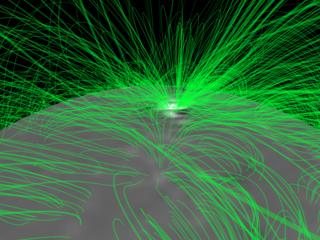
|
|
We begin our flight through the loops, noting that the more prominent regions on the surface have a higher density of field lines.
Available formats:
2560 x 1920
TIFF
4 MB
320 x 240
PNG
121 KB
160 x 80
PNG
23 KB
80 x 40
PNG
6 KB
|
|
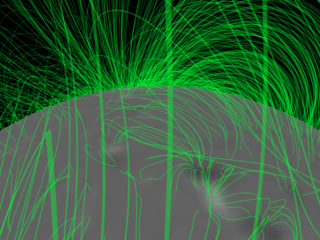
|
|
We end the tour on completing the orbit.
Available formats:
2560 x 1920
TIFF
4 MB
320 x 240
PNG
110 KB
|
|
|
Back to Top
|